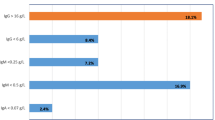Abstract
Behçet’s disease (BD) is a multisystemic inflammatory disorder of unknown etiology. Hyperimmunoglobulinemia has been demonstrated in BD; however, its clinical importance has not yet been discovered. In a few reports, an association between BD and plasma immunoglobulin E (IgE) has been noted. In this study, we had three objectives: (1) to investigate plasma levels of IgE and their association with levels of acute phase reactants, (2) to determine whether treatment has any effect upon IgE levels, and (3) to assess whether higher serum levels of IgE provide a clue for the diagnosis of BD. Fifty-two patients with BD, without any accompanying disease or condition that might lead to a rise in IgE, were compared with 51 age-matched healthy controls. Plasma levels of IgE, IgA, IgG, and IgM were analyzed by means of nephelometric analysis. Results showed that among the 52 patients, 23 (44%) had IgE levels that were higher than the upper limits of normal. IgE was not correlated with age, erythrocyte sedimentation rate, or C-reactive protein (p=0.59, p=0.57, and p=0.757, respectively). These relationships remained nonsignificant when multiple regression analysis was performed, with R 2 of 0.187 and p=0.057. Moreover, treatment of patients with elevated IgE did not produce any predictable IgE response. We conclude that Behçet’s patients commonly exhibit elevated plasma IgE levels. However, elevated IgE levels are not correlated with levels of acute phase reactants or disease activity. We suggest that IgE levels might be an independent diagnostic clue in Behçet’s patients.
Similar content being viewed by others
References
Yurdakul S, Hamuryudan V, Yazici H (2004) Behcet syndrome. Curr Opin Rheumatol 16:38–42
Fessler BJ (2004) Behcet’s syndrome. In: Koopman WJ (ed) Arthritis and allied conditions. Williams & Wilkins, Baltimore, MD, pp 1835–1844
Cengiz K (1990) Serum IgE concentrations in complete Behcet’s disease. J Clin Pathol 43:262
Scully C, Boyle P, Yap PL (1982) Immunoglobulins G, M, A, D and E in Behcet’s disease. Clin Chim Acta 120:237–242
Gul A (2001) Behcet’s Disease: an update on pathogenesis. Clin Exp Rheumatol 19:S6–S12
Fresko I (2002) Highlights of the 10th International Congress on Behcet’s Disease. Clin Exp Rheumatol 20:S59–S64
Author information
Authors and Affiliations
Corresponding author
Rights and permissions
About this article
Cite this article
Onat, A.M., Buyukhatipoglu, H., Yilmaz, M. et al. Immunoglobulin E: a new diagnostic clue for Behçet’s disease?. Clin Rheumatol 26, 81–83 (2007). https://doi.org/10.1007/s10067-006-0335-x
Received:
Revised:
Accepted:
Published:
Issue Date:
DOI: https://doi.org/10.1007/s10067-006-0335-x




